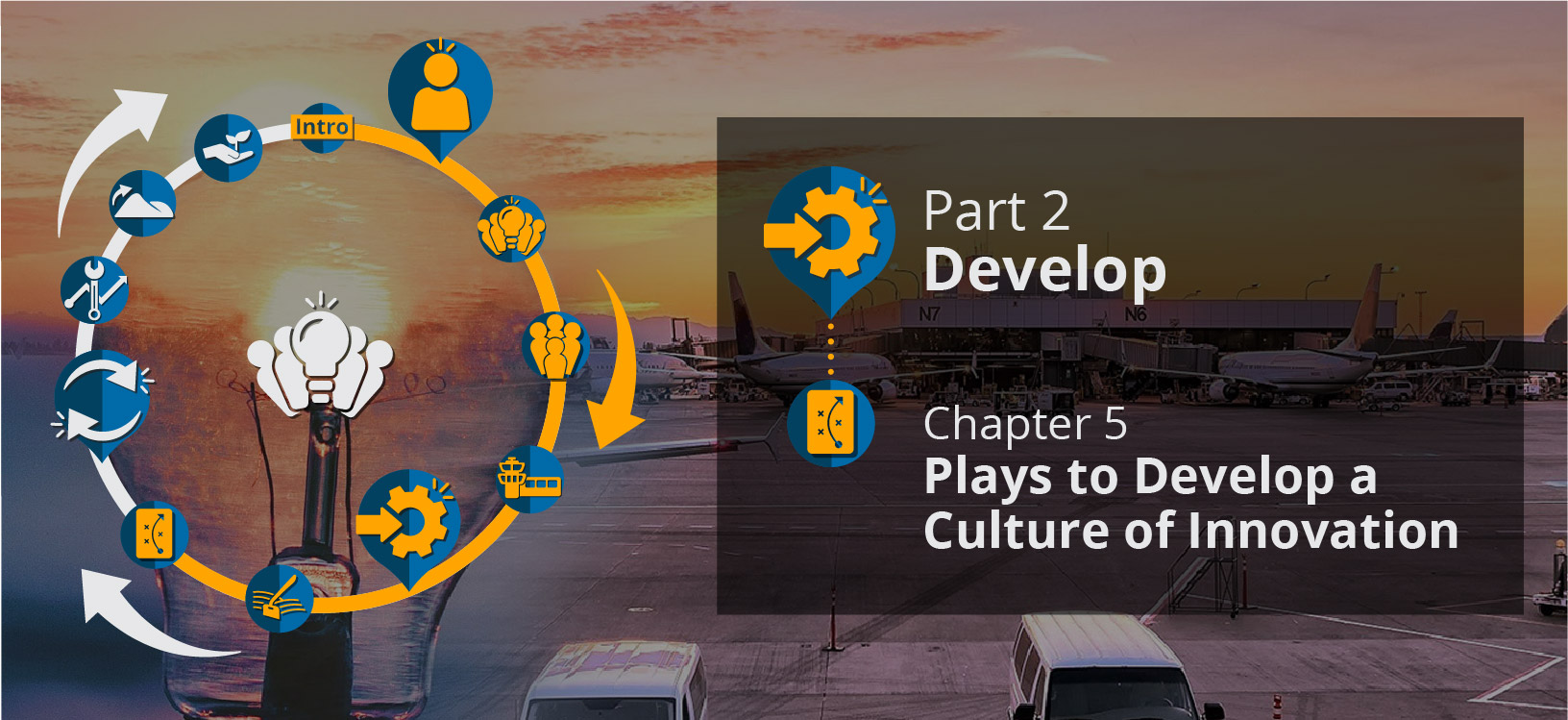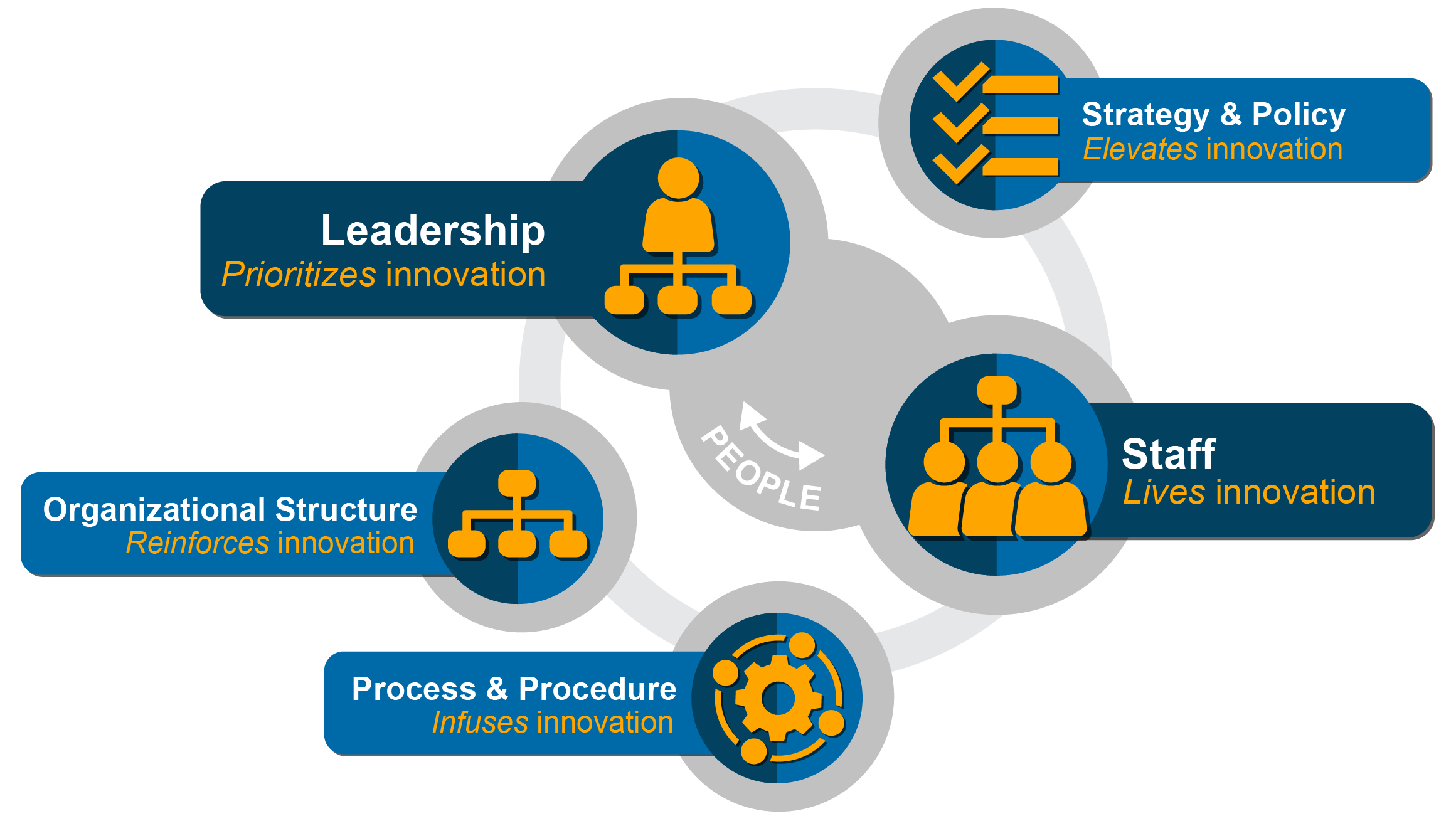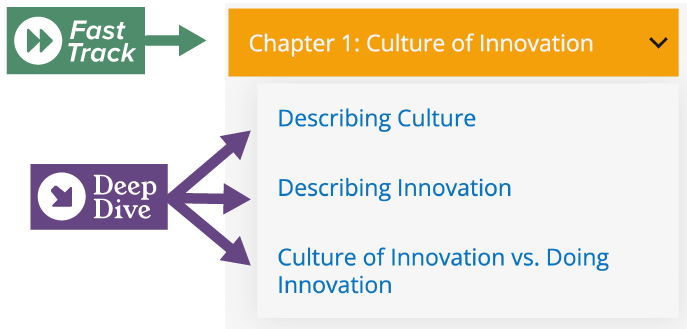
Chapter 5: Plays to Develop a Culture of Innovation
The following are actionable plays that you can use as you engage with members of your organization to foster a culture of innovation. Developing a culture of innovation involves tapping into the five organizational elements that influence culture (see Figure F5.1). And while many of the proposed actions in this playbook may be written for readers in leadership roles, information will also be provided to give ideas to staff members who may want to support their leaders take these actions.

Figure F5.1: Organizational Elements Aligned to Develop a Culture of Innovation.
Leadership: Becoming an Innovative Leader
Leadership plays an essential-if not the most critical-role in driving innovation at an airport. Research has shown that a leader at the highest level is typically the main catalyst for initiating an airport's move toward a culture of innovation. Therefore, it is important to start there. Some characteristics of innovative leaders include:
- Passionate about what they do.
- Make innovation a personal priority and organization-wide focus.
- Willing to take risks to reach goals.
- Not afraid of pushback.
- Collaborate with and support others, make employees feel safe.
- Open to change.
- Accountable and trusted.
- Motivate and encourage others to take risks.
- Mostly sustainers, accelerators, enablers and catalysts who help propel innovation.
Check out Plays 1-5, and click the title of each play to learn more in the Deep Dive.
- Formalize innovation (form a plan, create a culture of innovation team, provide innovative training, measure progress).
- Make innovation a daily habit (schedule innovation, gather feedback, encourage respectful challenging).
- Learn how to inspire others (show passion; communicate vision; have strong integrity; be authentic; be open, approachable, and inclusive; celebrate the successes of others).
- Seek and value all opinions. (Capture diverse thoughts from all ages, levels, genders, ethnicities, etc.; employ active listening skills; know limits; and seek wisdom from others.)
- Give space to explore ideas. (Ideate to solve problems, establish clear expectations, and respectfully make the call on ideas that are not ready to be implemented.)
- Encourage learning opportunities. (Provide on-the-job training, offer outside-the-job training, benchmark with other airports, and delegate responsibility.)
- Equate "maintaining status quo" with negative behavior (do not preserve the existing state of affairs, be brave, risk making changes, lead by example).
- Evaluate what is and is not working (seek improvement first, make inquiries, pursue transparency).
- Demonstrate ways to improve the customer experience (capture customer insights, maintain focus on the customer).
Play 4: Seek Affordable Solutions
- Understand the various levels of innovation. (Do not equate big dollars with big innovation; find new revenue-generating prospects.)
- Get creative about budgeting innovation. (Spread costs among projects; let partnerships help fuel the fire.)
Play 5: Put the Customer First
- Everyone has a role (remember everyone is in this together, include the so-called supporting cast).
- Develop a system to collect customer feedback (collect information, capture illusive data).
- Allocate time to evaluate customer feedback (evaluate and decipher data, turn customer feedback into action, prioritize and cut).
Staff: Becoming an Innovative Staff Member
Becoming an innovative staff member means always looking for ways to improve. This means aligning internal values to support continuous improvement and developing a mindset of innovation. Some characteristics of innovative staff members include:
- Contribute to the airport's strategic plans and live out its values.
- Put the mission of the organization first over personal gain.
- Improve the customer experience by learning and experimenting with new ideas and evaluating progress on new solutions.
- Collaborate to create an environment that is supportive and safe.
- Support open discussion with one another.
- Debate ideas in a respectful manner.
Check out Plays 6-10, and click the title of each play to learn more in the Deep Dive.
Play 6: Develop an Innovation Mindset
- Avoid the stigma associated with "failure" (collaborate and lead by example, replace "failure" with "experimentation," focus on the continuous learning cycle).
- Encourage open communication related to experimenting (get to know others, bring ideas forward).
- Use a fail-fast methodology to experiment and document results (test ideas quickly, get leaders on board).
Play 7: Create a Safe Environment
- Be a safe person, and advocate for a safe environment.
- Encourage leaders to set up a formal process for suggestions (advocate for voices to be heard, suggest ideas for feedback).
- Learn ways to challenge the status quo in a respectful manner (agree to disagree, keep calm and listen well, act like a reporter).
- Build networks to impact positive change (know who to connect with, know how to connect).
- Manage issues by openly discussing them (research, debate, reconcile, repeat; advocate for collaborative methods).
Play 9: Focus on Behaviors that Support Change
- Ask "why" and "what if" questions (spark innovation with questions, ask the right types of questions).
- Agility training and tools (learn about agility training, then become an advocate).
- Learn how to break through a change-resistant culture (change minds one at a time, bring in the troops).
Play 10: Improve Communications
- Choose communication methods well.
- Know how to communicate.
Strategy & Policy: Developing Strategies & Policies that Prioritize Innovation
Innovation needs to be a priority in strategy and policy in order for it to become a value that is incorporated into the culture. Strategies and policies need to integrate organizational functions, align goals to a common mission, and ensure that all departments are accountable for their decisions.
Leaders use strategic plans to
- Set unifying goals for everyone to meet;
- Add innovative values like experimenting, creativity, diversity and collaboration to the culture;
- Mold the environment to support behaviors that reflect innovation; and
- Help an airport meet organizational goals and exceed customer expectations through continuous improvement.
Staff members use strategic plans to
- Get clarity about the organization's goals, and
- Create change by always looking for more efficient ways of doing things.
Check out Plays 11-15, and click the title of each play to learn more in the Deep Dive.
Play 11: Develop a Unifying Strategic Plan
- Reference the strategic plan so it is widely known (announce the plan, follow up and celebrate progress, review and update plans).
- Use the strategic plan to guide all decisions across departments and roles (set daily reminders, provide incentives).
- Work with HR to reflect the strategic plan in hiring and performance review processes (ensure people reflect the desired culture, update HR communications).
Play 12: Align with Organizational Values that Support Innovation
- Ensure values are communicated as part of regular training (innovative leaders show what they value, are what they practice).
- Measure adherence to values via staff performance reviews (set expectations, develop related behaviors, update templates regularly).
Play 13: Focus on the Long Term
- Invest in long-term, sustainable innovation strategies (share their fears, move mountains).
- Monitor culture to ensure it reflects long-term objectives (evaluate the vital signs, provide a sense of safety and security).
- Conduct future trend analysis (look forward because the future is bright, be on trend and watch for changes).
Play 14: Prioritize an Exceptional, Comprehensive Team
- Capture the benefits of a diverse organization. (Stay in touch and mitigate biases.)
- Remain vigilant of potential challenges in a diverse organization. (Prioritize effectively, remain transparent, and promote a sense of unity.)
Play 15: Drive Innovation into HR Policies and Practices
- Include innovation in job responsibilities, regular training, and performance evaluations (see innovation as everyone's job, provide training opportunities, work with HR).
- Include innovation in the new-hire process (see onboarding as more than orientation).
- Provide incentives and rewards for participating in the innovation process (reward good behavior, encourage improvement and collaboration).
- Create permanent innovation-related job positions (have courage to make organizational chart modifications).
Organizational Structure: Developing the Organizational Structure to Reinforce Innovation
Organizational structures can help or hinder innovation from taking hold in a culture by
- Defining the relationships between people and positions at an airport, and
- Determining task and reporting relationships that affect how employees collaborate to achieve an airport's goals.
Leaders can reorganize or augment an organization's structure to reinforce the innovation they are seeking. Staff can find ways for the structure to support collaboration among business functions and identify key changes to promote the new culture of innovation.
Overall, aligning the organization with a clear focus on the purpose and outcomes of a culture of innovation will position it to provide holistic financial support to the pursuit.
Check out Plays 16-20, and click the title of each play to learn more in the Deep Dive.
Play 16: Aligning Organizational Structure to Support Innovation
- Gauging the success of your organizational structure (remove dysfunction for innovation functionality, assess pros and cons of each organizational structure, understand the hierarchical structure, understand the organic structure).
- Cultivating innovation in your culture (innovate the organizational structure, form teams to synergize innovation, ensure teams function well).
Play 17: Effectively Roll Out Structural Changes
- Provide training ideas and tools.
- Paint the vision.
Play 18: Develop Strategies by Business Function to Overcome Resistance to Change
- Provide new ways of thinking.
- Offer ways to open up conversations.
Play 19: Create a Collaborative Work Environment
- Can't address what you don't know (understand generational differences).
- Offer teams and partnership opportunities (collaborate with outside stakeholders).
Play 20: Emphasizing Organizational Budgets to Support Innovation
- Create an innovation piggy bank.
- Put money toward motivation.
Process & Procedure: Developing Processes & Procedures to Infuse Innovation
An organization's processes and procedures can either support or prevent business functions from innovating together regularly.
Leaders can
- Look for ways to help staff live out innovation in their daily tasks,
- Establish processes (from overarching policies) and procedures to make innovation integral to everything that everyone does, and
- Make innovation a motivating factor to keep employees interested in continuous improvement.
Staff can
- Consider "how they do their work" and
- Engage their team members in robust dialogues about process improvements in key areas of the airport business.
Both staff and leaders who spend time learning how their work impacts other business functions can broaden perspectives about the processes and procedures in their own areas and how to make tangible changes for the betterment of the entire organization.
Check out Plays 21-25, and click the title of each play to learn more in the Deep Dive.
Play 21: Discover What Motivates Employees
- Reward inspirational ideas.
- Take the time to find out what motivates each individual.
Play 22: Structure Time for Speculation
- Devote time to think, think, think.
- Learn from others.
Play 23: Provide Innovation-Related Learning Experiences
- Offer inside-out opportunities.
- Offer outside-in opportunities.
- Offer professional opportunities.
Play 24: Collaborate with Internal and External Partners
- Promote collaborative teams across departments (when you win, we all win)
- Promote collaborative teams with outside partners (close the gap, be community-centric).
Play 25: Focus on Learning by Transferring Knowledge
- Develop a knowledge-transfer database system (avoid experiential loss, rightsize knowledge capture).




